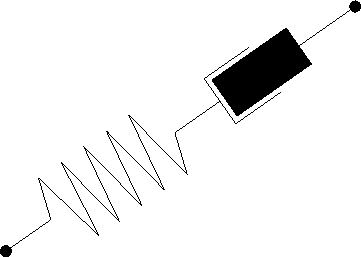
|
A more realistic approach to model the oxide and nitride layer is the assumption of a visco-elastic compressible fluid. In this case the stress is calculated from both the strain and the strain rate. The commonly used Maxwell body (Fig. 5.1) for the description of this phenomenon is analogous to a spring and a dashpot in series. The shape of the oxide is influenced by the history of the sample. This model must also be solved self consistently because of the close coupling.
The model is based on the idea that the dilatational components of the
stress which involves the volumetric expansion, respectively compression,
and the deviatoric part which only accounts for shape modifications,
are decoupled. Thus, Hook's law can be written as
The temporal evolution of the deviatoric components can directly
be written as follows [Sen96]:
Indeed, the deviatoric part of Maxwell fluid can be written as
| (5.17) |
The analytical solution of this equation gives the temporal evolution of the
stress as a function of the strain velocity:
| (5.18) |